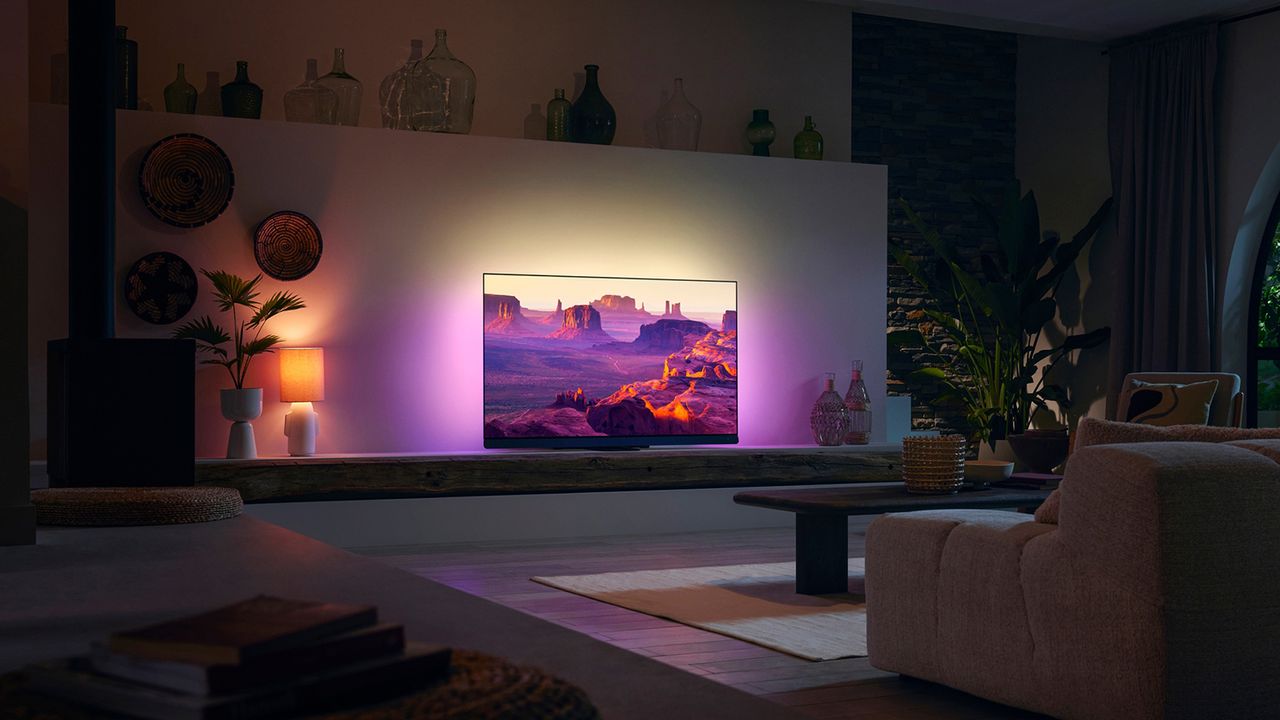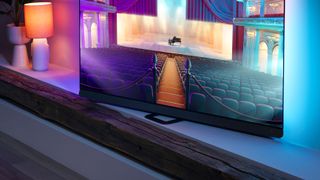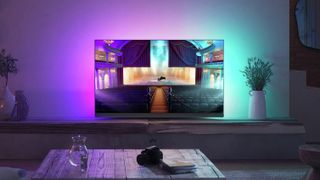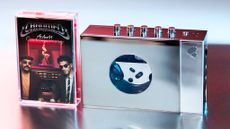TechTvsI tested the Philips OLED+908 and think classic OLED TV has a very bright futureThe OLED+908 with Ambilight and Bowers & Wilkins sound features a Micro Lens Array panel for ultra-bright picturesWhen you purchase through links on our site, we may earn an affiliate commission.Here’s how it works.
TechTvsI tested the Philips OLED+908 and think classic OLED TV has a very bright futureThe OLED+908 with Ambilight and Bowers & Wilkins sound features a Micro Lens Array panel for ultra-bright picturesWhen you purchase through links on our site, we may earn an affiliate commission.Here’s how it works.
The OLED+908 with Ambilight and Bowers & Wilkins sound features a Micro Lens Array panel for ultra-bright pictures
When you purchase through links on our site, we may earn an affiliate commission.Here’s how it works.
(Image credit: Philips)

(Image credit: Philips)
Nestled away adjacent to Barcelona’s Nou Camp stadium, TP Vision - the tech brand behind Philips TVs and, under Ambilight TV, is the sleeve sponsor of FC Barcelona - presented me with its latest andgreatest TV for 2023: the Philips OLED+908 (an update of the earlierOLED+907model). And it’s an ultra-bright bonanza that proves there’s still a very bright future in traditional OLED TV yet.
Image1of5(Image credit: Future / Mike Lowe)(Image credit: Future / Mike Lowe)(Image credit: Future / Mike Lowe)(Image credit: Future / Mike Lowe)(Image credit: Future / Mike Lowe)
Image1of5(Image credit: Future / Mike Lowe)(Image credit: Future / Mike Lowe)(Image credit: Future / Mike Lowe)(Image credit: Future / Mike Lowe)(Image credit: Future / Mike Lowe)
Image1of5
(Image credit: Future / Mike Lowe)(Image credit: Future / Mike Lowe)(Image credit: Future / Mike Lowe)(Image credit: Future / Mike Lowe)(Image credit: Future / Mike Lowe)
(Image credit: Future / Mike Lowe)(Image credit: Future / Mike Lowe)(Image credit: Future / Mike Lowe)(Image credit: Future / Mike Lowe)(Image credit: Future / Mike Lowe)
(Image credit: Future / Mike Lowe)
(Image credit: Future / Mike Lowe)
(Image credit: Future / Mike Lowe)
(Image credit: Future / Mike Lowe)
(Image credit: Future / Mike Lowe)
(Image credit: Future / Mike Lowe)
(Image credit: Future / Mike Lowe)
(Image credit: Future / Mike Lowe)
(Image credit: Future / Mike Lowe)
(Image credit: Future / Mike Lowe)
(Image credit: Future / Mike Lowe)
(Image credit: Future / Mike Lowe)
(Image credit: Future / Mike Lowe)
(Image credit: Future / Mike Lowe)
(Image credit: Future / Mike Lowe)
(Image credit: Future / Mike Lowe)
(Image credit: Future / Mike Lowe)
(Image credit: Future / Mike Lowe)
(Image credit: Future / Mike Lowe)
(Image credit: Future / Mike Lowe)
(Image credit: Future / Mike Lowe)
(Image credit: Future / Mike Lowe)
(Image credit: Future / Mike Lowe)
(Image credit: Future / Mike Lowe)
(Image credit: Future / Mike Lowe)
Which sets the Philips OLED+908 in good stead: after all, LG provides the MLA panel to Philips, it’s just the latter brand calls it a ‘META OLED’ panel instead and, paired with different processing engines and tuned differently, will inevitably deliver adifferentimage. But it’s no less bright, with the promise of 2100 nit peaks making it a clear contender for evenQD-OLED contendersfromSamsung (S95C)andSony (A95L)alike. Which is the other reason that 2023 is a particularly special year: this rival OLED technology also promises ultra-bright images, hence MLA being such an important counter option.
So what exactly is MLA? Micro Lens Array is as it sounds: a layer of microscopic lenses that receive the self-emissive output of OLED and ‘focus’ the light in order for it to be more forward projecting, minimising light dissipation and resulting in a brighter image overall. The Philips OLED+908 features 42.4 billion of these lenses in its panels. Yes,billion. And while obviously I can’t count such lenses (they’re far too small and I’d be there forever), what I can say after seeing the Philips OLED+908 set in action is that it’soh-so bright, proving that traditional OLED hasn’t lost its fight just yet. This is one neutrally balanced, clean-looking yet ultra-bright set.
(Image credit: Philips)

(Image credit: Philips)
Anyway, back to my actual OLED+908 demonstration: Philips presented a variety of stills and moving images to show-off why the set is so adept at bright output and motion-handling in ways that QD-OLED can’t always rival. Sure, the demonstration was fixed in a super-bright mode, so there was no Filmmaker Mode ‘as the maker intended’ or any of that, on which I can comment (yet). But it made it clear Philips has the tools to deliver visuals with gusto, just like its main rivals.
Sign up to the T3 newsletter for smarter living straight to your inbox
Get all the latest news, reviews, deals and buying guides on gorgeous tech, home and active products from the T3 experts
(Image credit: Philips)

(Image credit: Philips)
For me, having lived with the LG G3 and Panasonic MZ2000 prior, the Philips OLED+908 actually has more appeal for a number of reasons: first, it includes a stand-mount in the box, as I don’t want to pay extra for the LG (which comes with wall-mount components only); second, while I love the Panasonic MZ2000’s soundsystem, the Philips and Bowers & Wilkins partnership seems like the ideal solution in a less chunky set (and its earlier (and more powerful, soundbar-style arrangement)OLED+937was phenomenal); thirdly, I’m an Ambilight advocate so that’s just a major bonus for someone like me.

If you ever needed proof that cassette players are back, this is itWe Are Rewind has made a portable tape deck so retro it should appear from nowhere in a DeLorean
We Are Rewind has made a portable tape deck so retro it should appear from nowhere in a DeLorean

PS5 could finally be getting Gears of War and Halo after game-changing decisionThe age of exclusives is coming to an end
The age of exclusives is coming to an end
